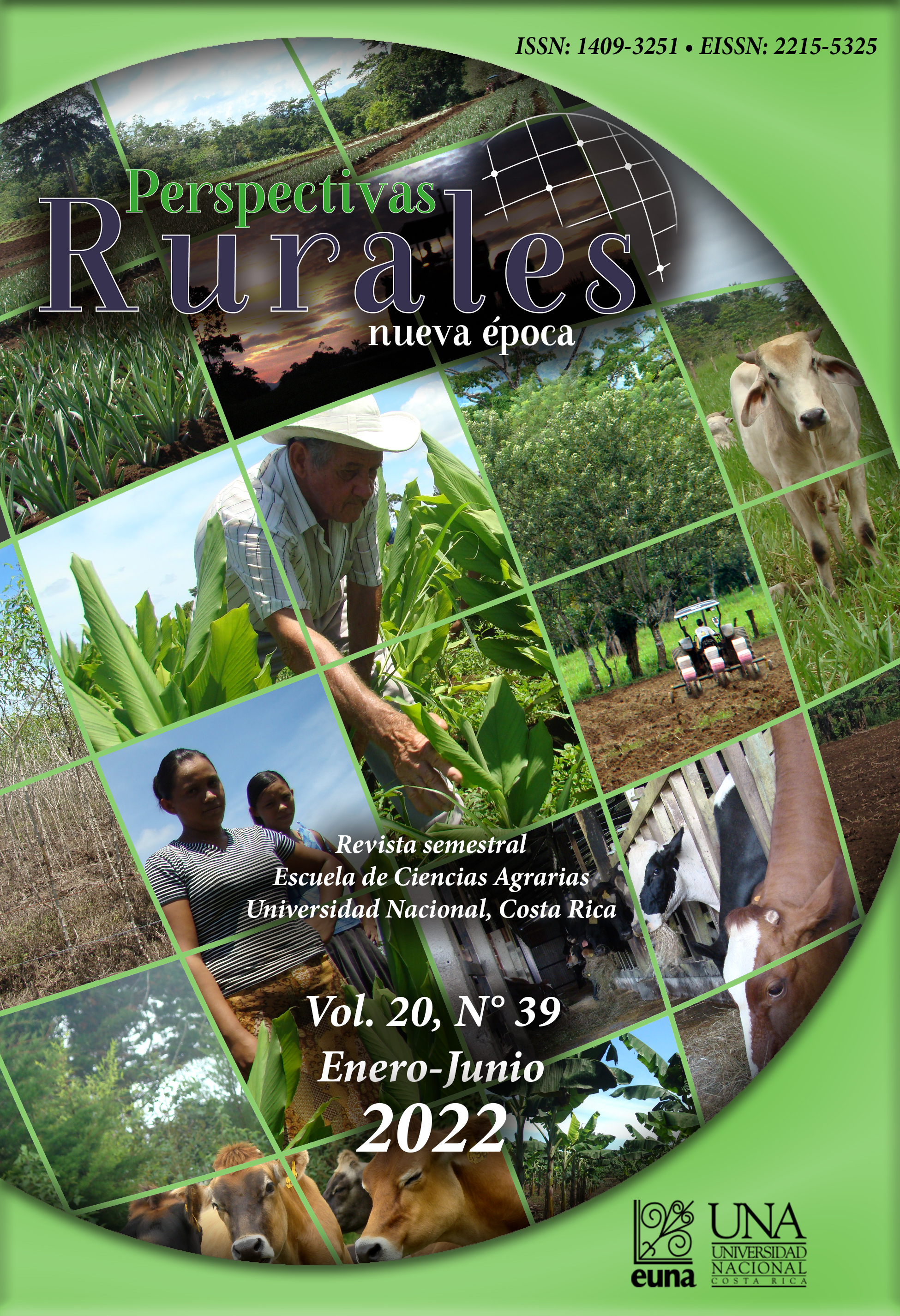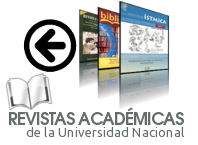Greenhouse gas emissions from a coffee plantation (Coffea arabica) with and without shade of moringa trees (Moringa oleifera) under organic and mineral fertilization in Barva de Heredia
DOI:
https://doi.org/10.15359/prne.20-39.1Keywords:
Carbon dioxide, Coffee, Methane, Mineral fertilization, Nitrate oxide, Organic fertilizationAbstract
Greenhouse gas emissions with two fertilization patterns (organic and mineral) with or without shade of Moringa trees (Moringa oleifera) were compared in a coffee plantation (Coffea arabica), Obata variety, in the Santa Lucía Experimental Farm in Barva, Heredia, Costa Rica. The following was conducted for the treatments; T1: with shade and organic fertilization, T2: with shade and mineral fertilization, T3: without shade and organic fertilization, and T4: without shade and mineral fertilization. Emissions were measured for only three different gases: carbon dioxide (CO2), methane (CH4), and nitrate oxide (N2O). Three fertilizations were conducted (mineral and organic) since 2016 and, by 2018 every time there was fertilization, greenhouse gases were sampled using the closed chamber technique for subsequent analysis by chromatography. Gas samples were taken during the three annual fertilizations on days 0, 5, 15, and 30, following application. Sub-samples were extracted from each sample on minute 0, 10, 20, and 30, right after the trap chamber was set. Emissions were also related to climate variables such as temperature, humidity, and precipitation. Different outcomes were obtained for each gas. Gas emissions were lower under shade. Regarding types of fertilization, emissions were higher in organic treatments compared to mineral fertilization. Only carbon dioxide emissions showed correlation with climate factors, registering higher values as temperature increased.
References
Castro, A., Henríquez, C. y Bertsh, F. (2009). Capacidad de suministro de N, P y K de cuatro abonos orgánicos. Agronomía Costarricense. 33(1). [Archivo PDF] https://www.mag.go.cr/rev_agr/v33n01-031.pdf
El-Hage, N. y Hattam, C. (2003). Agricultura orgánica, ambiente y seguridad alimentaria. FAO: Ambiente y Recursos Naturales. N.º 4. FAO, Roma. https://www.fao.org/3/y4137s/y4137s00.htm
Holdridge, L. (1967). Life Zone Ecology. Edición revisada. CCT. San José, Costa Rica. [Archivo PDF] http://reddcr.go.cr/sites/default/files/centro-dedocumentacion/holdridge_1966_-_life_zone_ecology.pdf
Instituto Interamericano de Cooperación para la Agricultura. (2014). Participación del sector agropecuario latinoamericano en las negociaciones de la Convención Marco de las Naciones Unidas sobre el Cambio Climático y en otros foros
internacionales. San José, Costa Rica. [Archivo PDF] http://infoagro.net/archivos_Infoagro/Ambiente/biblioteca/ES_213vbfh225561.pdf
López, A., Rodríguez, L. M., Lubo, C. M., Abadía, J., Orozco, O. A., Sandoval, J. y Arenas, F. (2018). Evaluación de las emisiones de GEI por fertilización del cultivo de caña de azúcar, desde un enfoque en dinámica de sistemas. Vol. 36(1).
doi.10.14482 [Archivo PDF] http://www.scielo.org.co/pdf/inde/v36n1/2145-9371-inde-36-01-00003.pdf
Louro, A., Báez, D., García, M. y Castro, J. (2010). Emisiones de Óxido nitroso en un suelo cultivado con maíz tras el aporte de distintos tipos de fertilizantes. Centro de Investigaciones Agrarias de Mabegondo. Coruña, España. [Archivo PDF]
http://ciam.gal/uploads/publicacions/841archivo.pdf
Montenegro, J. y Abarca, S. (2001). Importancia del sector agropecuario costarricense en la mitigación del calentamiento global. San José, Costa Rica. Ministerio de Agricultura y Ganadería. ISBN9977-9921-9-3. [Archivo PDF] http://www.
mag.go.cr/bibliotecavirtual/P01-6074.pdf
Nationally Appropiate Mitigation Actions. (2018a). NAMA Café: una herramienta para el desarrollo bajo en emisiones. NAMA Café de Costa Rica. [Archivo PDF] http://www.mag.go.cr/informacion/prog-nac-cafe-NAMA-herramientadesarrollo-bajo-en-emisiones.pdf
Nationally Appropiate Mitigation Actions. (2018b). NAMA Café: una herramienta para el desarrollo bajo en emisiones. NAMA Café de Costa Rica. [Archivo PDF] https://bit.ly/3LArtDk
Noponen, M., Edwards-Jones, G., Haggar, J., Soto, G., Attarzadeh, N. & Healey, J. (2012). Greenhouse gas emissions in coffee grown with differing input levels under conventional and organic management. Agriculture, ecosystems and environment. Vol. 151, 6-15. https://www.sciencedirect.com/science/article/abs/pii/S0167880912000345
Richards, M. (2013). ¿Es posible reducir las emisiones en la agricultura, a la vez que se mantienen los rendimientos? Climate Change Agriculture and Food Security. https://ccafs.cgiar.org/es/blog/%C2%BFes-posible-reducir-las-emisiones-enla-agricultura-la-vez-que-se-mantienen-los-rendimientos#.XjyHAGhKiUk
Rikxoort, H., Schroth, G., Läderach, P. y Rodríguez, B. (2015). Carbon footprints and carbon stocks reveal climate-friendly coffee production. Agronomy for Sustainable Development. Springer. doi. 10.1007. https://link.springer.com/
article/10.1007/s13593-014-0223-8
Segura, M. y Andrade, H. (2012). Huella de carbono en cadenas productivas de café (Coffea arabica L.) con diferentes estándares de certificación en Costa Rica. ISSN 1909-2474 [Archivo PDF] http://www.scielo.org.co/pdf/luaz/n35/n35a05.pdf
SINC. (2010). Fertilizantes orgánicos contra el cambio climático. https://www.agenciasinc.es/Noticias/Fertilizantes-organicos-contra-el-cambio-climatico
Sorgato, V. (2016). Emisión de CO2 tiene un lado positivo. Agronomía Sustentable. https://agronomiasustentable.wordpress.com/2016/09/12/emision-de-co2-tiene-un-lado-positivo/
Downloads
Additional Files
Published
How to Cite
Issue
Section
License
![]()
Revista Perspectivas Rurales. Nueva Época se encuentra bajo una licencia Creative Commons Reconocimiento-NoComercial-CompartirIgual 4.0 Internacional License.
Creado a partir de la obra en http://www.revistas.una.ac.cr/index.php/perspectivasrurales
Los autores/as que publiquen en esta revista aceptan las siguientes condiciones:
- Los autores/as conservan los derechos de autor y ceden a la revista el derecho de la primera publicación, con el trabajo registrado con la Licencia Creative Commons Atribución-NoComercial-CompartirIgual 4.0 Internacional, que permite a terceros utilizar lo publicado siempre que mencionen la autoría del trabajo y a la primera publicación en esta revista.
- Los autores/as pueden realizar otros acuerdos contractuales independientes y adicionales para la distribución no exclusiva de la versión del artículo publicado en esta revista (p. ej., incluirlo en un repositorio institucional o publicarlo en un libro) siempre que indiquen claramente que el trabajo se publicó por primera vez en esta revista.
- Se permite y recomienda a los autores/as a publicar su trabajo en Internet (por ejemplo en páginas institucionales o personales) antes y durante el proceso de revisión y publicación, ya que puede conducir a intercambios productivos y a una mayor y más rápida difusión del trabajo publicado.






